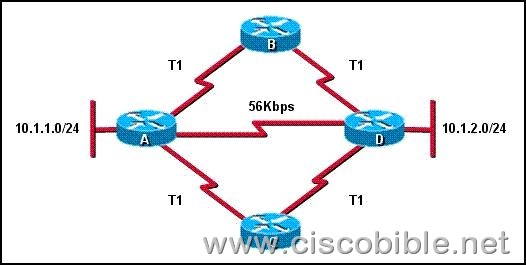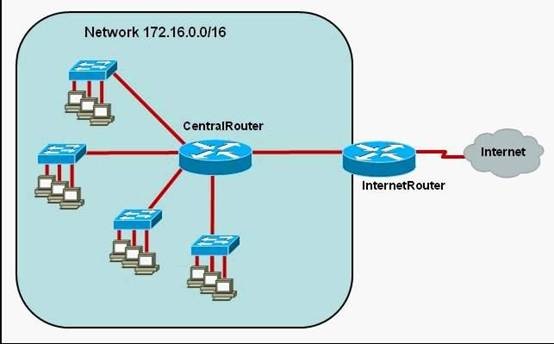|
This page was exported from Free Cisco Training & Resources - Certification Exam Preparation
[ https://www.ciscobibles.com ] Export date: Tue Nov 4 15:40:36 2025 / +0000 GMT |
CCNA 640-802 Bible - Compare and Contrast Methods of Routing and Routing
A: the sequencing and acknowledgment of link-state packets B: the requirement for a hierarchical IP addressing scheme for optimal functionality C: the high volume of link-state advertisements in a converged network D: the high demand on router resources to run the link-state routing algorithm E: the large size of the topology table listing all advertised routes in the converged network Correct Answers: B, D Explanation: The main drawbacks to Link State protocols are the amount of CPU overhead involved in calculating route changes and memory resources that are required to store neighbor tables, route tables, and a complete topology map. In addition to being resource intensive, link state routing protocols are hierachical by design using the concepts of areas in OSPF or levels in IS-IS, so a hierarchical IP addressing sceme is need for optimal routing functionality.
A:If RIPv2 is the routing protocol, only the path AD will be installed in the routing table by default. B:If RIPv2 is the routing protocol, the equal cost paths ABD and ACD will be installed in the routing table by default. C:If EIGRP is the routing protocol, only the path AD will be installed in the routing table by default. D:If EIGRP is the routing protocol, the equal cost paths ABD and ACD will be installed in the routing table by default. E:If EIGRP and OSPF are both running on the network, the EIGRP paths will be installed in the routing table. F:If EIGRP and OSPF are both running on the network, the OSPF paths will be installed in the routing table. Correct Answers: A, D, E Explanation: Path selection criteria for RIP and RIPv2 is hop count so path AD will be used because of 1 hop count. Choice A is correct. EIGRP has lower administrative distance of 90 than OSPF 110 so EIGRP will be preferred. Choice D is correct. EIGRP uses bandwidth for the path selection criteria and load balances by default for equal cost paths, making choice F correct.
A:a dynamic routing protocol on InternetRouter to advertise all routes to CentralRouter. B:a dynamic routing protocol on InternetRouter to advertise summarized routes to CentralRouter. C:a static route on InternetRouter to direct traffic that is destined for 172.16.0.0/16 to CentralRouter. D:a dynamic routing protocol on CentralRouter to advertise all routes to InternetRouter. E:a dynamic routing protocol on CentralRouter to advertise summarized routes to InternetRouter. F:a static, default route on CentralRouter that directs traffic to InternetRouter. Correct Answers: C, F
A: The router will use the static route. B: The router will use the OSPF route. C: The router will use the EIGRP route. D: The router will load balance and use all three routes. Correct Answers: A Explanation: When a router learns about the same network via multiple sources, the router will choose the source with the lowest administrative distance (AD). By default, the AD for these routing protocols are: Connected Interface has 0 AD Static Route : 1 EIGRP : 90 OSPF : 110 So, the static route will be chosen since it has the lowest AD.
A: RIP B: BGP C: OSPF D: EIGRP Correct Answers: D
A: a directly connected interface with an address of 192.168.10.254/24 B: a static route to network 192.168.10.0/24 C: a RIP update for network 192.168.10.0/24 D: an OSPF update for network 192.168.0.0/16 E: a default route with a next hop address of 192.168.10.1 F: a static route to network 192.168.10.0/24 with a local serial interface configured as the next hop Correct Answers: A
Network 1 - 192.168.10.0 /26 Network 2 - 192.168.10.64 /27 Network 3 - 192.168.10.96 /27 Network 4 - 192.168.10.128 /30 Network 5 - 192.168.10.132 /30 A:RIP version 1 B:RIP version 2 C:OSPF D:EIGRP Correct Answers: B, C, D Explanation: Because this network is using IP subnets with variable length subnet masks, only routing protocols that support VLSM will fit this particular case. The routing protocols that support VLSM are RIP v2, EIGRP and OSPF. |
|
Post date: 2009-08-03 17:00:50 Post date GMT: 2009-08-03 09:00:50 Post modified date: 2010-07-23 00:04:17 Post modified date GMT: 2010-07-22 16:04:17 |
| Powered by [ Universal Post Manager ] plugin. HTML saving format developed by gVectors Team www.gVectors.com |

